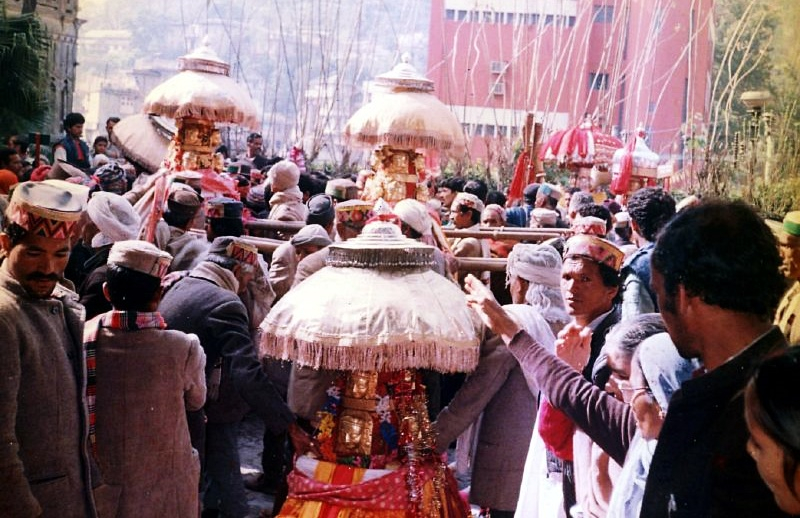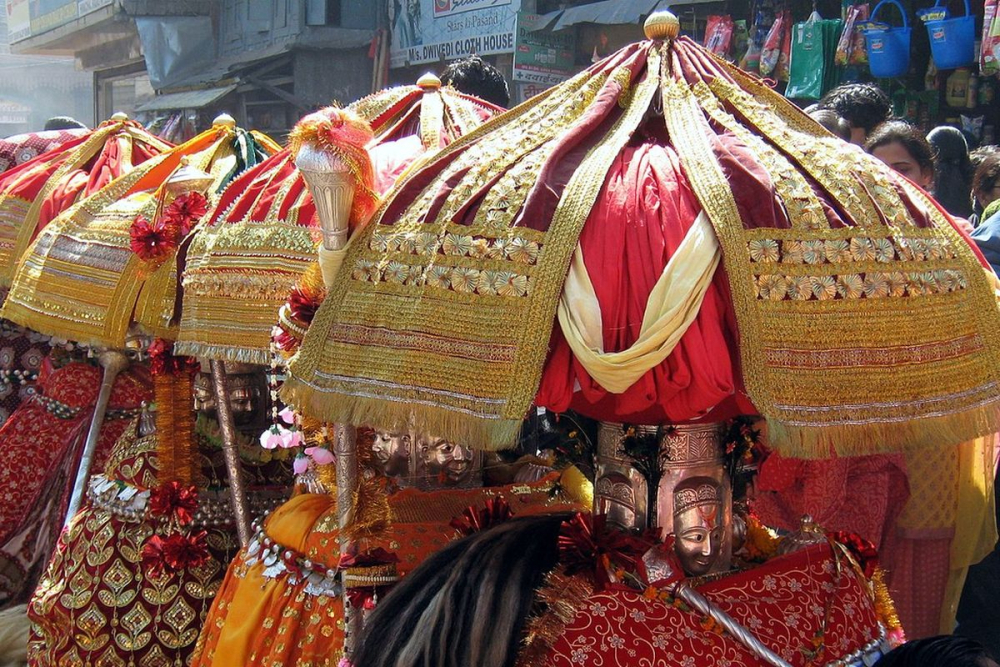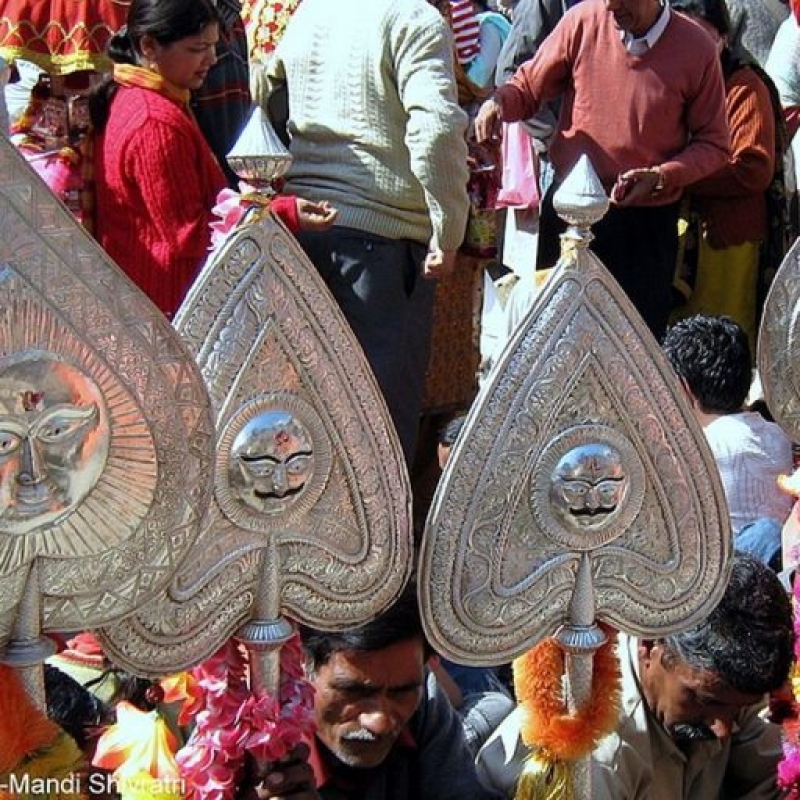Maha Shivaratri is a festival celebrated all across India. While people in some parts of the nation pay their respects to Shiva by fasting, in other areas, devotees flock to temples dedicated to Shiva. We explore Mandi’s seven-day Shivaratri fair and why it is celebrated. (In pic: Devotees ready for jaleb at the Mandi Shivaratri mela; Photo courtesy: Wikimedia Commons)
Among the variety of Hindu fasts and days fixed for the worship of a specific god, Maha Shivaratri is one of the most important. Observed across the country, this celebration is more meditative than festive, with people beginning their fast a day prior to the festival, chanting mantras and praying to the venerated Shiva. However, in Mandi, a small town in Himachal Pradesh, jubilation and gaiety manifest in the form of the seven-day Shivaratri Mela (fair).
There is a reason why Mandi is often called the ‘Varanasi of the hills’ and ‘chhoti Kashi’ (little Kashi). In fact, residents of the region boast that while Kashi (as Varanasi is also known) has 80 temples, the small town built along the banks of the river Beas has 81! While one may not have gone around counting the number of temples in both towns, it has been said that one such attempt was made in 1919, and at the time the count was almost 50 in Mandi.
Also Read | The Tradition and Culture of Devi-Devta Worship in Himachal Pradesh
Most of these temples are dedicated to Shiva, with the Trilok Nath Temple, Pachvaktra Temple and the Bhootnath Temple being the most important ones. The Bhootnath Temple is where the centuries-old Shivaratri Mela is held. Historian and Indologist Elisabeth Conzelmann explores the possible origin of the temple and the fair in her 2006 paper, ‘A Royal Ritual of Mandi State’. She writes, ‘In local Rajput history, it is described thus: after his victory (in 1526), Ajbar Sen thought of building a palace and a capital’ and that ‘the temple of Bhootnath (Siva) was built where the linga of the deity had revealed itself.’ It is believed that the Maha Shivaratri Mela began with the establishment of the Bhootnath Temple.
Interestingly, while the event is held in honour of Bhootnath—and since around the late seventeenth or early eighteenth century, Madho Rai, a form of Lord Vishnu, as well—the fair has proved to be a congregation point for hundreds of local deities from Mandi and its surrounding towns and villages.

Confluence of gods
This confluence is a fascinating example of how local deities, traditions and lore are often seamlessly enmeshed in Indian cultural celebrations. Around 200 mobile statues of gods and goddesses are carried on ornate palanquins by devotees from distant villages, sometimes travelling for two–three days on foot. These processions are accompanied with the playing of shehnais (Indian oboe), karnals (long wind instrument), thonkrus (a large trumpet) and drums. As they pass through neighbourhoods, people rush to windows and rooftops to witness the dancing palanquins draped in red and orange cloths called chadars.
Known as jaleb in the local dialect, these processions also include gurs (oracle priests who serve as the voices of the deities) and pujaris (priests). Once in Mandi, the processions are taken out locally for three of the seven days of the mela. They begin at the Bhootnath Temple, and are led by the most important deity of the festival—Madho Rai.

Who is Madho Rai?
According to historians, the Bhootnath Temple was the main temple of Mandi until the late 1600s, when the local ruler of the state, Raja Suraj Sen, built the ‘Madho Rai Temple’ dedicated to Lord Vishnu. He installed Madho Rai as the protector deity of Mandi.
As Prof. Karuna Goswamy explains, this was because all of Raja Suraj Sen’s offspring (the number varies from 17–18) had died right after birth, and he was worried that he would not have an heir. On the advice of his priest, Suraj Sen converted to Vaishnavism and installed Madho Rai as the king of the state, himself functioning as the dewan of the deity.
Related | Kullu Dussehra of Himachal Pradesh
According to the historian Manu V. Devadevan, the ‘Shaivite rulers’ of Mandi ‘adopted Madho Rao as their tutelary deity’ and that ‘something similar is found in southern India, where the rulers of Travancore dedicated the kingdom to Padmanabha and ruled as his representatives’. Conzelmann says that the mela that had begun with the establishment of the Bhoothnath Temple assumed a two-fold quality under Madho Rai and was conflated with the features of a darbar (a royal court assembly), where deities from the neighbouring villages and towns came to pay their respects to Madho Rai.
Festivities and celebration
The other two gods of considerable importance at the festival are Kamru Nag and Parashar Rishi. While Parashar Rishi was ‘the oldest and the most powerful kulj (lineage god) of the rulers’,[i] Kamru Nag has ‘a direct link with the capital, the ruler and Bhootnath, and the three of them were linked together in the rain ritual called garua’.[ii] Kamru Nag’s association with rain makes him an important deity, the first one to be received by Madho Rai. After reaching Mandi and paying respects at the Bhootnath Temple, the palanquin of Kamru Nag is taken to the temple of Tarna Devi atop a hill from where he observes the proceedings of the festival.
Also Read | Traditional Festivals, Popular Culture and Bastar’s Tryst With Modernity
During the seven-day fair, people from the town and the neighbouring villages flock to the grounds for darshan, to ask questions and to receive blessings from the various deities who are carried on the shoulders of the palanquin bearers with joy and gaiety. In the temples, the priests carry out the rituals and practices, reciting mantras to please the gods present in the town. Today, even though the festival has witnessed various changes over the years—officials of the Indian government replacing the king as the host of the fair, the ban on the ritualistic sacrifice of goats at various temples during the Shivaratri fair in 2014 and the modernisation of the fair through cultural events that involve famous celebrities—numerous gods and goddesses still grace the small town of Mandi with their presence, creating an atmosphere of joy and festivity.
This article was also published in The Statesman.
Notes
[i] Elisabeth Conzelmann, ‘A Royal Ritual of Mandi State’, European Bulletin of Himalayan Research, 2012, accessed October 24, 2019, https://pdfs.semanticscholar.org/f55e/5f9887ede3a01009c48c07be6749e05b893a.pdf?_ga=2.264655558.813448385.1571930090-1243786649.1571930090.
[ii] Ibid.













